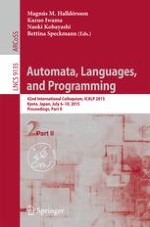2015 | Buch
Automata, Languages, and Programming
42nd International Colloquium, ICALP 2015, Kyoto, Japan, July 6-10, 2015, Proceedings, Part II
herausgegeben von: Magnús M. Halldórsson, Kazuo Iwama, Naoki Kobayashi, Bettina Speckmann
Verlag: Springer Berlin Heidelberg
Buchreihe : Lecture Notes in Computer Science
